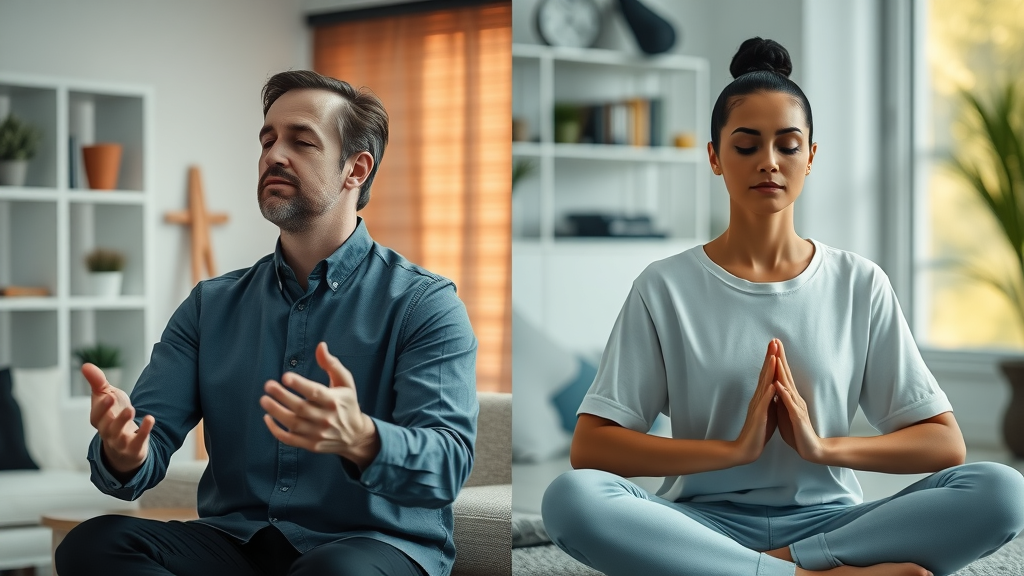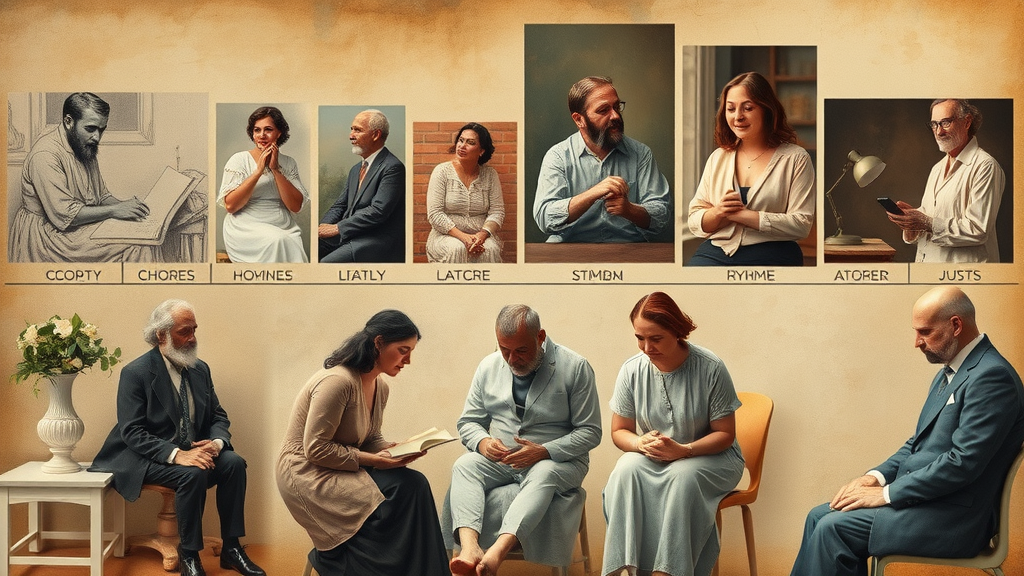What if you could transform your mind and body’s response to pain, stress, or anxiety simply by tapping into your imagination? Recent research shows that nearly 75% of participants in clinical studies report measurable improvements using guided imagery in hypnosis for a vast range of issues—from stress and chronic pain to performance enhancement. This powerful tool is catching the attention of both clinicians and everyday people seeking natural, personalized healing strategies. In this comprehensive guide, you'll learn why guided imagery in hypnosis is gaining ground, how it works, and exactly what happens during a session.
“Nearly 75% of participants in clinical studies report measurable improvements using guided imagery in hypnosis for conditions ranging from stress to chronic pain.”

Startling Fact: The Effectiveness of Guided Imagery in Hypnosis
Guided imagery in hypnosis is rapidly emerging as an effective tool in the world of therapeutic interventions due to its impressive results across diverse issues. Real-time clinical observations and studies consistently highlight its positive impact—not just as a relaxation technique, but as a means to reshape thought patterns, reduce stress, and promote lasting change in the subconscious mind. In a systematic review, individuals suffering from chronic pain, including cancer patients, reported major reductions in symptoms by regularly engaging in imagery exercises as part of hypnosis and guided therapy routines.
Beyond pain management, guided imagery in hypnosis is increasingly recommended by mental health professionals for reducing blood pressure, supporting improved sleep, and helping to interrupt negative thought cycles that can drive anxiety or depression. Unlike passive mindfulness practices, this approach involves interactive guided imagery led by a therapist, making it a powerful tool for changing habits and mental health. The evidence is clear: harnessing the imagination through guided imagery can unlock profound healing and resilience when paired with the focused suggestibility of a hypnotic state.
What You'll Learn about Guided Imagery in Hypnosis
- Core principles and theory behind guided imagery in hypnosis
- How guided imagery differs from guided meditation
- Step-by-step process for using guided imagery in hypnosis
- Key applications such as pain management and anxiety reduction
- Expert insights on efficacy and best practices
Understanding Guided Imagery in Hypnosis
At its core, guided imagery in hypnosis is a structured process where a trained professional leads you to imagine scenes, scenarios, or sensations that evoke positive physical and emotional responses. This unique blend of imagination and suggestion allows you to bypass conscious resistance and directly engage the subconscious mind, making it a powerful tool for transformation. Different from ordinary daydreaming, guided imagery in hypnosis is carefully designed to target specific outcomes—whether reducing chronic pain, encouraging muscle relaxation, or reframing negative thought patterns that undermine mental health.
Many people are already familiar with guided meditation, but guided imagery in hypnosis goes a step further. It actively employs verbal cues, multisensory details, and interactive techniques within a hypnotic state to deepen engagement and drive real change. Through proven methods refined over decades, both the environment and the imagery are carefully crafted to elicit a state of focused attention where therapeutic suggestions readily take root.
Guided Imagery vs. Guided Meditation: Key Differences
While both guided imagery and guided meditation involve visualization, there are fundamental distinctions in intent, process, and outcome. Guided meditation commonly centers on present-moment awareness, gentle redirection of thoughts, and cultivation of mindfulness—a great practice for stress reduction and emotional balance. However, during a hypnosis session involving guided imagery, the practitioner leads you into a deeper hypnotic state where the subconscious becomes highly receptive to positive, goal-driven suggestions.
In meditation, the experience is often solitary, with minimal intervention. By contrast, guided imagery in hypnosis is interactive, sometimes involving real-time dialogue and adaptation based on the client’s reactions. The structured, therapeutic approach means imagery exercises are personalized, evolving with your mental health goals and physical needs. This makes interactive guided imagery a robust complement to mindfulness practice and other complementary therapies, particularly for those seeking tangible, lasting results in pain management or behavioral change.

Core Elements of Hypnosis and Guided Imagery
- Defining guided imagery in hypnosis: The intentional use of vivid, multisensory mental images, guided by a practitioner, to achieve a specific therapeutic goal within a hypnotic state.
- How interactive guided imagery enhances engagement: The real-time involvement—asking questions, adapting scenarios—fosters a deep sense of presence and amplifies the impact of suggestions.
- Role of suggestion and focus: Hypnosis leverages focused attention, enabling the subconscious mind to accept positive statements and new perspectives with greater ease.
Theoretical Foundations of Guided Imagery in Hypnosis
To fully appreciate why guided imagery in hypnosis is so effective, it's important to understand both its historical roots and its scientific validation in modern mental health care. These approaches have evolved from early trance techniques to today’s evidence-based integrative therapies, always focusing on the mind’s ability to create real change through imagined experiences.
Historical Development of Guided Imagery and Hypnosis
The story begins centuries ago with early hypnotic practices and suggestion-based healing methods. Historical records document the use of trance states for medical conditions, ritual healing, and pain management, long before “hypnosis” was formally defined. In the 20th century, scientific interest in guided imagery and hypnosis intensified, leading to a rise in clinical studies and structured protocols. Influential mental health pioneers integrated visualization with progressive muscle relaxation and suggestion, transforming how chronic pain and emotional distress were treated. Today, the seamless combination of guided imagery, mindfulness practice, and traditional hypnotherapy forms the foundation for many complementary therapies worldwide.

Neuroscience: How Guided Imagery in Hypnosis Influences the Brain
Current neuroscience sheds light on why guided imagery in hypnosis works as an effective tool for change. Studies using real-time brain imaging reveal that vivid mental images created during hypnosis activate the same neural pathways as the actual experiences. This “virtual rehearsal” allows clients to develop new responses to pain, anxiety, or negative thought patterns. When a therapist embeds healing suggestions within guided imagery, the subconscious mind forms new connections—literally rewiring old habits. This is especially impactful for conditions like chronic pain, where the brain’s pain centers can be skillfully downregulated using imagery exercises, muscle relaxation, and positive suggestion.
Furthermore, this process supports improved sleep, lowers blood pressure, and boosts the body’s natural relaxation response. Clinical trials show cancer patients, for example, reporting less distress and pain, while others benefit from improved resilience in stress reduction. By aligning ancient wisdom with modern science, guided imagery in hypnosis continues to expand as both a complementary therapy and a gold standard in modern hypnotic care.
How Guided Imagery in Hypnosis Works: A Step-by-Step Guide
| Step | Description | Tips |
|---|---|---|
| Preparation | Create a calming environment and set clear intentions. | Use music, dim lights. |
| Induction | Begin hypnosis with relaxation and focused attention. | Deep breathing techniques. |
| Imagery Introduction | Introduce vivid, positive imagery tailored to individual goals. | Use multisensory details. |
| Interactive Guided Imagery | Engage the participant actively in the scenario. | Ask exploration questions. |
| Suggestion Phase | Embed therapeutic suggestions within imagery. | Keep language positive and affirming. |
| Emergence | Gently return the individual to normal awareness. | Allow gradual transition. |
Let’s break down each step in this guided imagery in hypnosis process. First, the environment is deliberately soothing, often featuring gentle lighting, plants, and relaxing music to promote a hypnotic state. Induction follows, using progressive muscle relaxation and focused breathing to deepen client comfort and open subconscious pathways. As you move into the imagery introduction, tailored mental images—such as a calm forest or warm sunlight—set the scene for therapeutic change.
The interactive phase is what sets hypnosis and guided methods apart from standard relaxation exercises. The therapist encourages active participation, sometimes asking the client to make choices within the imagery or describe sensations in real time. During the suggestion phase, positive, affirming statements aligned with personal goals are woven into these mental images. Finally, the emergence stage ensures clients return to full wakefulness refreshed, carrying the benefits of their experience into daily life.

Applications of Guided Imagery in Hypnosis
One of the reasons guided imagery in hypnosis is growing in popularity is its adaptability across many mental health and medical conditions. The personalized nature of interactive guided imagery ensures relevance, whether the focus is chronic pain, emotional well-being, or goal achievement. Let’s explore the main uses supported by science and clinical experience.
Pain Management: Using Guided Imagery in Hypnosis
Persistent pain can dramatically affect quality of life, and traditional medication isn’t always the answer. Guided imagery in hypnosis offers a gentle, non-invasive option for pain management—especially when addressing chronic pain linked to stress or inflammation. Imagery exercises during a hypnosis session might include imagining warmth flowing through an area of discomfort or visualizing pain as a changing color or shape that gradually fades. A study published in pain journals found that this approach significantly helped cancer patients reduce their sense of suffering without side effects, truly acting as a powerful tool.
Through this technique, clients learn to retrain the brain’s relationship with pain, decreasing its intensity and increasing control. As mental health experts point out, these sessions also address the emotional burden of pain by promoting relaxation, resilience, and an optimistic mindset.

Anxiety Reduction and Stress Management with Guided Imagery
Anxiety and relentless stress can sap both physical and mental energy. Guided imagery in hypnosis is proven to reduce stress and break negative thought cycles that fuel anxiety. By creating vivid, safe spaces through imagination, clients build psychological resources that make daily stressors less overwhelming. Regular sessions with a hypnotherapist can help someone anchor a sense of calm and control that lasts long after the session ends.
Specific techniques include evoking sensory-rich safe havens, positive visual anchors, or moments of past achievement, all combined with progressive muscle relaxation. Research shows that people practicing these routines see considerable drops in anxiety symptoms and improvements in overall mental health and sleep. This targeted stress reduction approach is now a staple recommendation in many holistic care and complementary therapies.
Enhancing Performance and Focus with Guided Imagery in Hypnosis
High-performance athletes, musicians, and professionals often use guided imagery in hypnosis to hone focus, boost confidence, and visualize success. By rehearsing desired outcomes in a controlled hypnotic state, the body and mind “learn” success, making it easier to replicate under pressure in the real world.
Coaches and therapists guide clients to imagine each step of a challenge—like a perfect game or confident speech—imbuing each mental image with sights, sounds, and emotions. This immersive approach strengthens neural pathways, optimizes focus, and minimizes performance anxiety. The result? A measurable edge in competitive, professional, and creative pursuits.
Interactive Guided Imagery: Making Hypnosis More Engaging
- Personalization strategies in interactive guided imagery: The most effective sessions are tailored to the client’s unique preferences, needs, and experiences. This can include selecting favorite nature scenes, meaningful symbols, or personal success stories as the core of the imagery exercises.
- Techniques for increasing imagery vividness and involvement: Therapists ask detailed, open-ended questions—What do you see, hear, feel? Can you make colors brighter or sounds clearer?—to encourage richer, more immersive visualization and deeper engagement of the subconscious mind.
A Guided Imagery in Hypnosis Session: What to Expect
For those new to guided imagery in hypnosis, knowing what to expect offers peace of mind and maximizes readiness for positive change. Here, we describe the structure of a typical session and the variety of client outcomes reported in clinical practice.
Typical Session Structure
Each session begins with a warm welcome and brief discussion to clarify your goals and address any fears or questions. The therapist then guides you through a calming induction—often using gentle music or progressive muscle relaxation—to establish a receptive hypnotic state. Vivid mental images, tailored to your needs, are introduced using clear, evocative language. You may be encouraged to interact or make choices within the scenario, amplifying your connection to the imagery.
Suggestions for healing, confidence, or comfort are gently embedded, supporting the desired outcome whether it’s pain management, reduced stress, or breaking unhelpful thought patterns. The session concludes with a gradual transition back to normal awareness, ensuring you feel refreshed, safe, and empowered to integrate the experience into your daily routine.
Client Experiences and Outcomes

Most clients describe sessions as deeply relaxing, safe, and even transformative. The ability to visualize vivid scenarios often improves with practice, leading to enhanced outcomes over time. Positive changes observed include lower pain, reduced stress or anxiety, improved sleep, and greater resilience in coping with medical conditions. For some, guided imagery in hypnosis unlocks subconscious pathways to healing that traditional therapy alone may not reach.
“Guided imagery in hypnosis can unlock subconscious pathways to healing in ways traditional therapy sometimes cannot.” – Clinical Hypnotherapist
People Also Ask about Guided Imagery in Hypnosis
Is guided imagery a form of hypnosis?
Answer: While guided imagery is often used within hypnosis sessions, it is not in itself hypnosis. Instead, it is a technique that leverages visual and sensory imagination, which, when paired with hypnotic induction, amplifies focus and suggestibility for therapeutic benefit.
What is an example of guided imagery?
Answer: An example of guided imagery is asking a patient to imagine walking along a peaceful beach, feeling the warmth of the sand and hearing the waves, thereby evoking relaxation and positive emotions.
How to use guided imagery in therapy?
Answer: Guided imagery in therapy involves leading a client through detailed mental images that evoke desired emotional or physical states, often to reduce anxiety, manage pain, or reinforce positive behaviors.
What are the four stages of guided imagery?
Answer: The four stages include Preparation, Induction, Imagery Experience, and Conclusion, each crucial for a successful guided imagery session in hypnosis.
Key Takeaways on Guided Imagery in Hypnosis
- Guided imagery in hypnosis engages the imagination for positive change.
- Combined approaches improve outcomes for pain and anxiety management.
- Personalization and interactivity are key to effective hypnosis using guided imagery.
- Clinical evidence supports the benefits and efficacy of this integrative approach.
Frequently Asked Questions about Guided Imagery in Hypnosis
-
What conditions can guided imagery in hypnosis help with?
Guided imagery in hypnosis is effective for chronic pain, anxiety, stress reduction, sleep disorders, and certain medical conditions, including support for cancer patients. -
Can anyone practice guided imagery in hypnosis?
Most people can benefit; however, sessions are best conducted by trained, certified practitioners for safety and optimal results. Special care is required for individuals with certain psychiatric conditions. -
Are there risks or side effects?
Guided imagery in hypnosis is generally very safe. Rarely, individuals may experience emotional release or discomfort if sensitive topics arise, which a skilled therapist can address immediately. -
How do I find a qualified practitioner?
Look for therapists certified in both hypnosis and guided imagery through reputable professional organizations. Check credentials, training, and client reviews for confidence in your choice.
In Summary: The Value and Future of Guided Imagery in Hypnosis
Guided imagery in hypnosis stands at the forefront of mind-body therapies, uniting ancient traditions and modern science to offer transformative results. As awareness and clinical research grow, this approach is set to become even more important in personalized mental health and wellness care.
Ready to Experience the Benefits? Find a Certified Guided Imagery in Hypnosis Practitioner Today
Take the next step toward stress relief, pain management, and personal transformation by seeking a certified guided imagery in hypnosis practitioner in your area. Harness the power of your imagination and unlock new pathways to wellness now.
 Add Row
Add Row  Add
Add 




Write A Comment